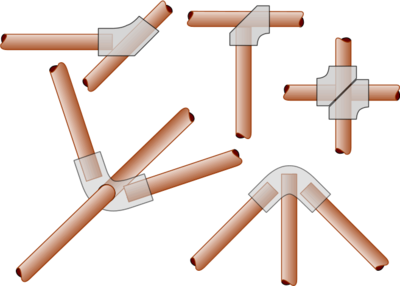Basic Kite Construction: Difference between revisions
From DT Online
mNo edit summary |
mNo edit summary |
||
| Line 1: | Line 1: | ||
:::::::::'''''''Anything flat, firm and fairly light in relation to its surface will make a kite.''''''' | :::::::::'''''''Anything flat, firm and fairly light in relation to its surface will make a kite.''''''' | ||
[[File:Rokkaku kite.svg|500px|right|Rokkaku kite|link= | [[File:Rokkaku kite.svg|500px|right|Rokkaku kite|link=http://commons.wikimedia.org/wiki/File:Rokkaku_kite.svg]] | ||
__TOC__ | __TOC__ | ||
Revision as of 09:25, 1 March 2017
- ''Anything flat, firm and fairly light in relation to its surface will make a kite.''
Frameworks
Spars can simply be taped to small paper kites. For larger kites, cross-joints can be bound with string and glue or fixed by cable ties.
More generally, very positive and quickly formed joints for the spars can be made using plastics tubing. 'Neoprene' and 'Polythene' are thermo-plastics, which means the material softens when heated and stiffens again when cold. It is easily cut and shaped to form joints as shown.
Holes can be made in flattened tube using a Paper Punch or the tubing may be clamped flat between two pieces of scrap wood and driiled through. Alternatively, a Soldering iron can be used to burn through any holes needed - but do so in a well ventilated area and avoid breathing in any fumes produced.
Materials available:
Spars -
- Drinking straws – for very small tissue paper kites
- Barbeque skewers – useful for small paper kites
- Wood dowel - a good material for kite building beginners but easily broken.
- Split bamboo garden canes and flower sticks - cheap and easily available. Tougher than dowel but not as smoothly finished
- Fibreglass rods and tubes - these are flexible, very strong, and inexpensive but the solid rods are fairly heavy.
- Carbon Fibre - the standard material for kites. It's strong, light and doesn't bend as much as fibre glass.
Sails –
- Newspaper - very cheap and easily available but has no strength when wet and has a poor strength to weight ratio.
- Tissue paper - available in bright colours and lightweight but poor strength when wet. Like newspaper, can be sprayed with water and left to dry to shrink tight.
- Brown paper or wrapping paper - stronger than newspaper but also can be heavier.
- Mylar - the silver hologram paper quite popular as a gift-wrap paper. It is very light, cheap and decorative but easily torn.
- Polyethylene - cheap and easily available in the form of waste bin liners and carrier bags. Difficult to glue but adheres to tapes well.
- Tyvek - a registered trademark of the 'DuPont' company. It is a synthetic material resembling paper but made of high-density polyethylene fibres and often used for packaging and disposable overalls. 'Tyvek' is very strong and difficult to tear but easily cut with scissors.
- Polyester cotton - the fabric that many modern items of clothing and household bedding are made from. A suitable weight for kite making is that used for making shirts or lightweight bed sheets.
- Rip-stop Nylon is a lightweight, water-repellent nylon fabric that resists ripping or tearing. It is often used in hot air balloons, kites, parachutes, camping equipment such as lightweight tents and sleeping bags, flags, and banners. 'Rip-stop Polyester' (or rip-stop Dacron) is becoming more common for kites because it stretches less than nylon and has greater strength for a given weight. The best way to cut rip-stop is with a "heat knife" or soldering iron with a flattened tip in a well-ventilated area - the fumes are unhealthy. Specialist adhesives are available but the best way to join fabrics in kite making is to use a sewing machine.
- Nylon Taffeta - is a light, plain-weave fabric with a high lustre, originally made from silk and now often used in single line kites.
Kite lines –
- Sewing cotton - can be used for small tissue paper kites
- Household linen string – not really suitable but can be used if necessary
- Braided, or twisted pair fishing line (NOT mono-filament line) - ask at the fishing shop for 'Dacron' line.
- Nylon cord - 50 lb. test nylon kite line can be used for diamond kites, small box kites, small and medium delta kites
- Polyester – braided polyester 'Dacron' line for single line kite flying is economical, tough and has half the stretch of nylon lines.
- High Density Polyethylene – sold under the brand names of 'Dyneema' or 'Spectra', and now the preferred material for sports kite lines for two main reasons: the low stretch means that control inputs to the kite are transferred quickly and secondly the low friction allows the kite to remain controllable up to about ten twists in the line.











